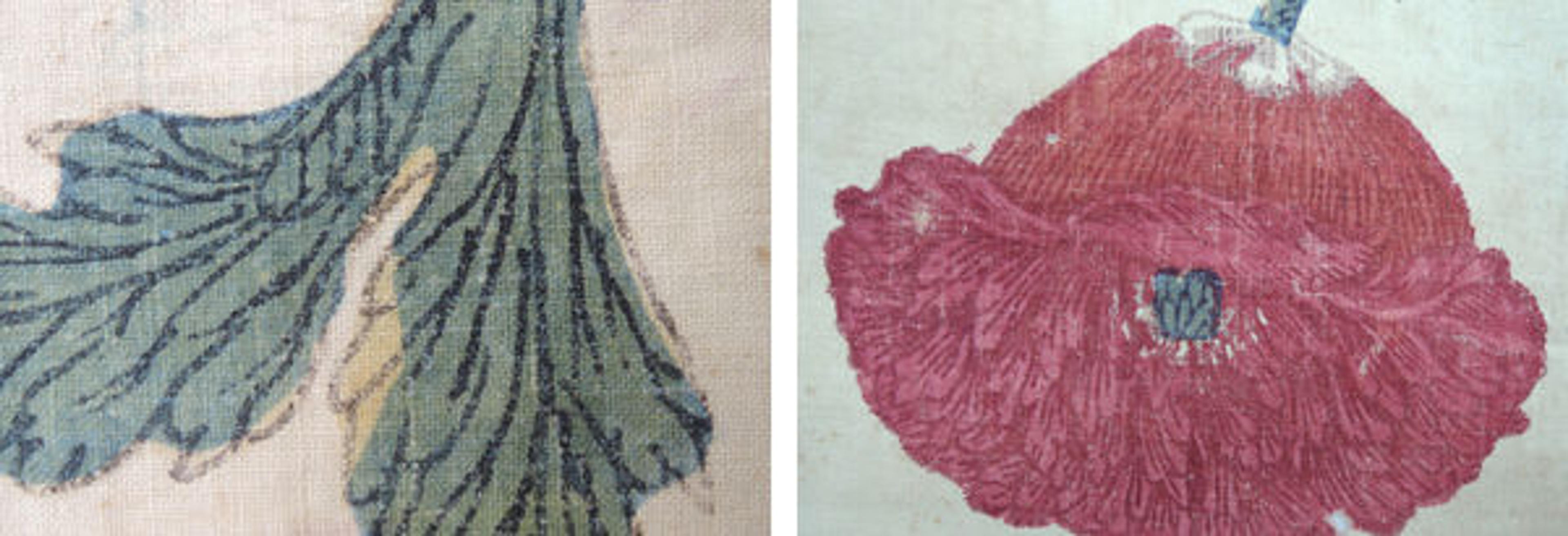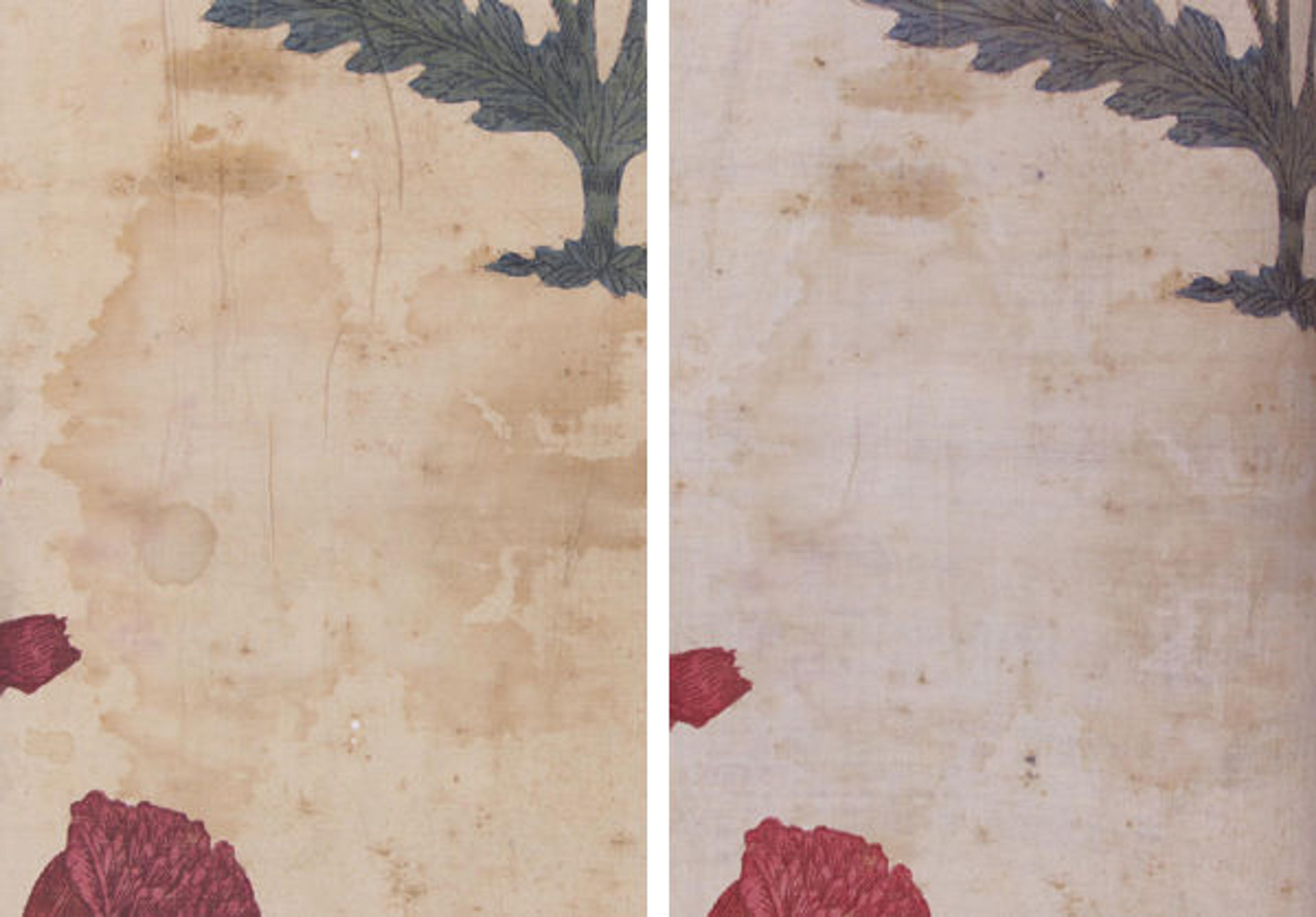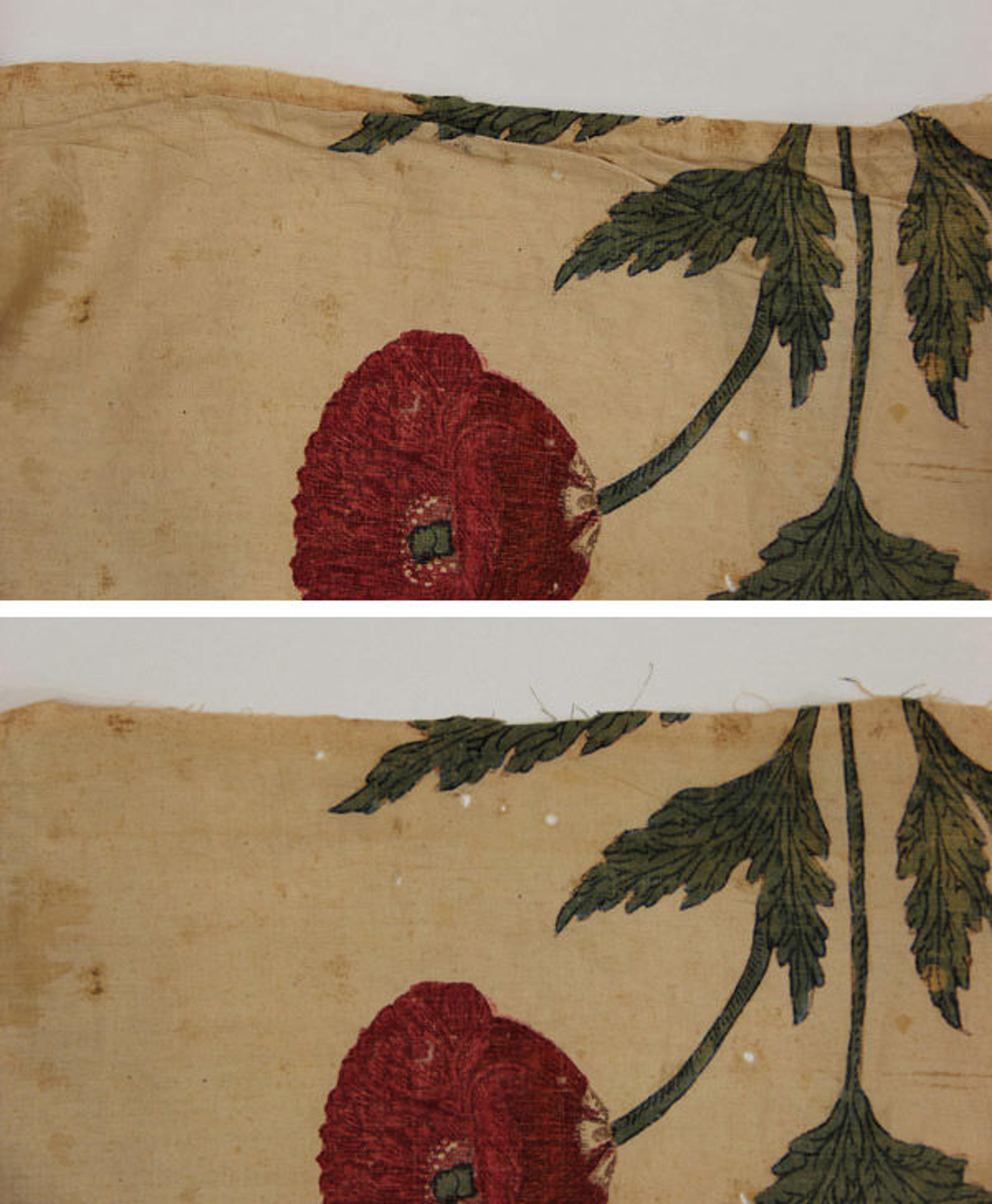From the Ground Up: Conservation Treatment of an Indian Textile

Two textile fragments installed on slant boards in gallery 464. Fragments of a floorspread, late 17th century. India, Mughal period (1526–1858). Islamic. Cotton; plain weave, mordant-painted and dyed, resist-dyed; L. 66 3/4 in. (169.5 cm), W. 142 in. (360.7 cm). The Metropolitan Museum of Art, New York, The Alice and Nasli Heeramaneck Collection, Gift of Alice Heeramaneck, 1982 (1982.239a, b). Photo by Julia Carlson
«Now on display in gallery 464 are two Indian textile fragments from the late seventeenth century that feature a repeating pattern of poppy flowers. Due to the fragility of the textile's border and the need for extensive conservation work, this installation marks the first time these textiles have been on display since they entered the Metropolitan Museum's collection in 1982.»
The textiles, known as dastarkanas ("summer carpets"), were produced in India in the late seventeenth and early eighteenth centuries. They have a bold pattern of repeated flowering poppy plants—one fully open blossom in the center top, with two buds below it on either side, and two blossoms in profile below the buds. This motif repeats in three offset rows, with the top row featuring alternating plants that are rotated downwards. There is also a green border present, with scrolling vines from which leaves and poppy blossoms extend. The technique used to create these designs is a complex, multistep process involving mordant and dye painting and resist-dye known as kalamkari, which translates to "pen work," referring to textiles with hand-applied, rather than block-printed, motifs (fig. 1).

Fig. 1. Detail of leaf (left) and flowering poppy plant (right) highlighting the mordant and dye painting by hand (1982.239b). Photos by Yael Rosenfield
While conducting research regarding these objects, I found that many other major museums have textiles with very similar motifs and overall compositions. One example at the Victoria and Albert Museum in London is intact (fig. 2) and illustrates what the Met's floorspread would most likely have looked like when it was first made in the late seventeenth century. One large difference between the two examples, however, is that the top row of the Met's textiles shows the poppies in alternating directions, while the Victoria and Albert piece displays the motif's direction in a consistent manner across each row.

Fig. 2. Example of an intact floor cover from the Victoria and Albert Museum. Measuring approximately 380 inches in length by 154 inches in height, the Met's textile fragments comprise a little less than half the size of this full-size floor cover. Parts of a floorspread, made late 17th century–early 18th century. Possibly made in Burhanpur, India. Resist-dyed and mordant dyed cotton. The Victoria and Albert Museum, London (IM.77-1938). Image © The Victoria and Albert Museum
Paintings from the time of the Mughal empire also provide context for the dastarkana. Visitors to gallery 464 will see a painting, Maharaja Sidh Sen Receiving an Embassy, located to the right of the summer carpet, depicting an early eighteenth-century floor cover.
The larger textile fragment (1982.239a) consists of three elements: the textile itself, the lining, and the red binding. All are plain weave cotton fabric, though the lining and binding were most likely added after the seventeenth century. The textile with poppy flowers has three horizontal panels joined by two seams. The middle panel is selvedge to selvedge, or edge to edge, and measures thirty-eight and five eighth inches. The top panel has a selvedge at the seam and is cut on top, while the bottom panel is cut at the seam and there is a selvedge at the bottom (fig. 3). The lining is undyed, with three horizontal seams that join four pieces that are selvedge to selvedge. The two middle pieces measure eighteen and a half inches, while the two outer pieces have a selvedge at the seam and are cut to fit the shape of the textile. The binding is a similar fabric to the lining, has been dyed red, and incorporates two seams. The smaller textile fragment is similar in all aspects, except the lining is exposed on the right side where the textile has been cut.
Left: Fig. 3. Macro image of the selvedge and weave structure of the bottom textile (1982.239a). Photo by Julia Carlson
Conservation work began on these textiles in 2014. They were in fair condition with numerous fragile areas that brought to light a number of conservation issues during the preparation for installation. In addition to the many stains and creases seen throughout, the red binding was distorting the exterior edge, which caused even more creasing. The many losses along the fragile green border also needed to be addressed, since handling and exhibition could further damage the object. Overall, the treatment took more than one hundred hours to complete.
Conservation began by vacuuming the textiles on a low suction. We decided that the binding and the lining needed to be removed to provide access to the back and to facilitate conservation work. While we initially considered washing the textile, it was later decided that, due to the fragility of the border, treatment of the stains should instead be addressed with a poultice—an absorbent material used in conservation to introduce water or solvents to a localized area in order to reduce or remove dye bleed, stains, and accretions. Laponite RD, a synthetic silicate, and deionized water were used to reduce the tideline stains (fig. 4); later, Agarose, a rigid disaccharide gel, and deionized water were used.

Fig. 4. Before (left) and after (right) details of tideline stain removal with Laponite RD and deionized water poultice on 1982.239a. Photos by Julia Carlson
Since the linings were less fragile and also stained, these were washed. Cotton fabric was dyed green and pink in the Department of Textile Conservation lab to match areas of loss and was stitched underneath these areas to stabilize the textile (fig. 5).

Fig. 5. Before (top) and after (bottom) details of treatment. The red binding was removed, the edges were humidified flat, and dyed fabric was stitched with couching stitches to the areas of loss for stabilization of the textile (1982.239a). Photos by Julia Carlson
Because the textiles were humidified flat in order to reduce the creases (fig. 6), they became slightly larger in size. Fabric of matching color and texture was used to replace the binding on the top right edge of the larger textile. After the washing of the linings and the vacuuming, stabilization, humidification, and poulticing of the textile, the lining and binding were reattached to the poppy textile on both the larger and smaller textiles.

Fig. 6. Before (top) and after (bottom) examples of the humidification of the edge of 1982.239a after the removal of the binding. Photos by Julia Carlson
Even though the fragments became more stable after treatment, we still did not want to stitch through the fine fabric with a poppy pattern, which is necessary for a Velcro hanging system. We instead opted for a slanted board to give the textiles even support, and distributed fine insect pins to hold them in place. The textiles were unrolled by departmental technicians and attached to the boards by conservators (figs. 7 and 8).

Left: Fig. 7. Florica Zaharia and Charles Dixon during the process of pinning and unrolling of the textile during installation (1982.239a). Right: Fig. 8. Minor adjustments are made and more pins are added by conservators (1982.239a). Pictured here are the author and Annick DesRoches, collections manager in the Department of Islamic Art. Photos by Laura Peluso
It is still a mystery as to why the textiles were cut into these puzzle-piece shapes. One theory is that they were cut and repurposed to fit into a space later in their history, or it may be that the full size of the textiles did not fit past columns or tent posts at some point. It was decided not to recreate the original appearance of these objects in order to be mindful of their unique history. From floor covers to museum displays, these textile fragments have had quite a journey.
In the Department of Textile Conservation, the author would like to thank Conservator in Charge Florica Zaharia and Conservator Janina Poskrobko for their expertise and guidance during this treatment.
Related Links
View all blog posts about the activities of the Department of Textile Conservation.
In Season: "A Flower to Remember" (August 18, 2015)
Julia Carlson
Julia Carlson is an assistant conservator in the Department of Textile Conservation.